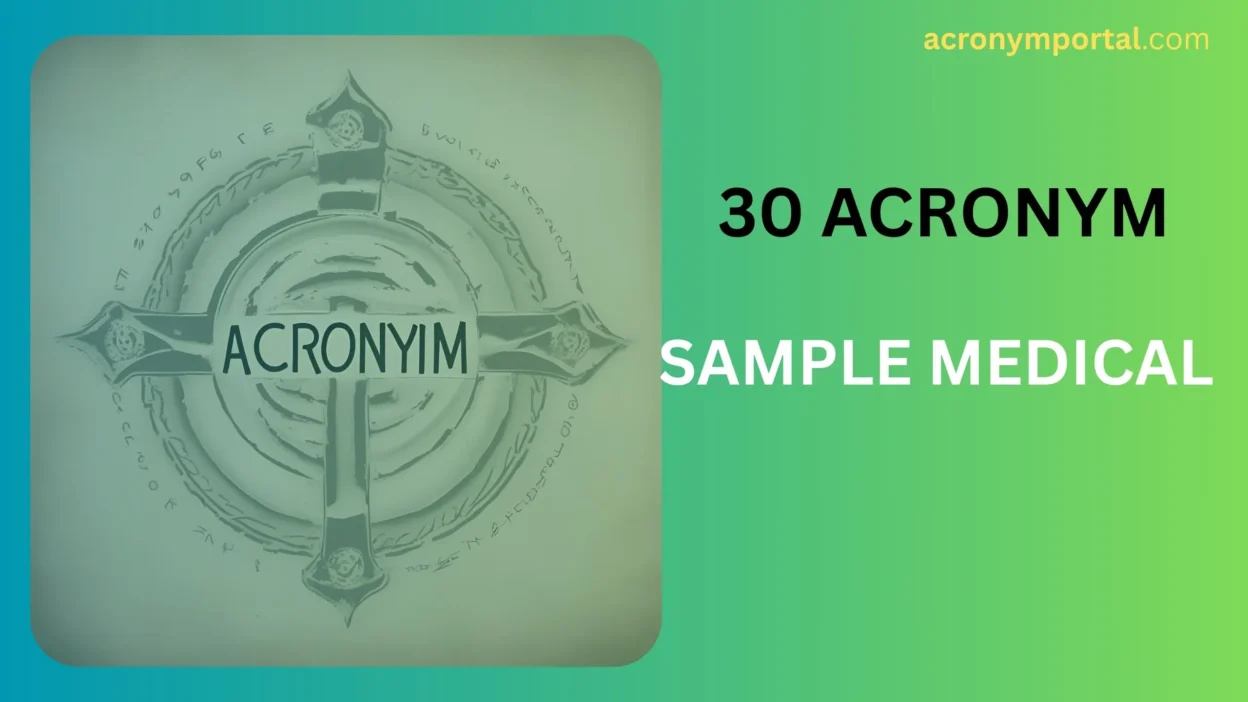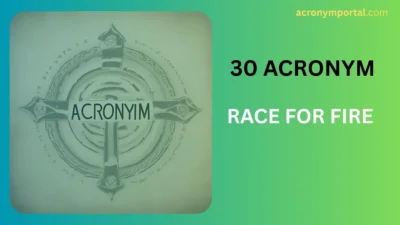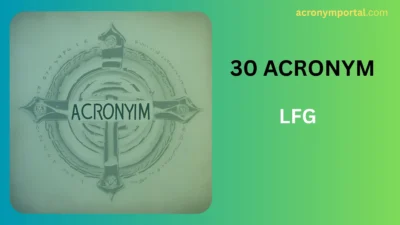In the medical field, acronyms are lifesavers—literally and figuratively. The term “Sample acronym (medical)” typically refers to the SAMPLE mnemonic used during emergency assessments to quickly gather patient history. It’s a vital communication tool for EMTs, paramedics, nurses, and doctors.
But what does SAMPLE stand for? Let’s start with that, and then we’ll explore 30 alternative acronyms that serve different purposes across emergency care, diagnostics, nursing, trauma management, and more.
Whether you’re a healthcare student, a first responder, or a medical writer, understanding these acronyms—and when to use them—can make your communication faster, more accurate, and more efficient.
🧾 What Does SAMPLE Stand For?
SAMPLE is a medical history acronym used primarily in emergency settings:
- S – Signs and Symptoms
- A – Allergies
- M – Medications
- P – Past medical history
- L – Last oral intake
- E – Events leading up to present illness/injury
Example:
“Use SAMPLE to gather a quick medical history before transport.”
When to use it:
During triage, pre-hospital assessments, or any emergency situation requiring rapid history-taking.
🔄 30 Medical Acronyms (Alternatives to SAMPLE) and When to Use Them
Each of these serves a specific purpose—some for trauma, others for assessment, diagnosis, or monitoring.
1. OPQRST
Meaning: Onset, Provocation, Quality, Radiation, Severity, Time
Example: “Use OPQRST for chest pain assessment.”
When to use: Detailed symptom analysis, especially pain.
2. ABCDE
Meaning: Airway, Breathing, Circulation, Disability, Exposure
Example: “Start with ABCDE in trauma care.”
When to use: Primary trauma or emergency assessment.
3. PEARL
Meaning: Pupils Equal And Reactive to Light
Example: “The patient’s pupils are PEARL—normal neuro check.”
When to use: Quick neurological assessments.
4. AVPU
Meaning: Alert, Verbal, Pain, Unresponsive
Example: “AVPU is used to measure consciousness.”
When to use: Rapid neurological screening.
5. DCAP-BTLS
Meaning: Deformities, Contusions, Abrasions, Punctures, Burns, Tenderness, Lacerations, Swelling
Example: “Use DCAP-BTLS for trauma surveys.”
When to use: Physical injury evaluation.
6. SOAP
Meaning: Subjective, Objective, Assessment, Plan
Example: “Document patient progress using a SOAP note.”
When to use: Clinical documentation in progress notes.
7. CAB
Meaning: Circulation, Airway, Breathing
Example: “Follow CAB for adult CPR.”
When to use: Cardiac arrest situations.
8. PERRLA
Meaning: Pupils Equal, Round, Reactive to Light and Accommodation
Example: “PERRLA indicates normal eye response.”
When to use: Full eye assessment, especially in neurology.
9. SAMPLE-R
Meaning: SAMPLE + Risk Factors
Example: “Include SAMPLE-R when assessing for stroke.”
When to use: When underlying risk factors are relevant.
10. FAST
Meaning: Face, Arms, Speech, Time
Example: “FAST test helped catch her stroke early.”
When to use: Stroke recognition.
11. GCS
Meaning: Glasgow Coma Scale
Example: “GCS score is 12—mild head injury.”
When to use: Assessing level of consciousness after trauma.
12. APGAR
Meaning: Appearance, Pulse, Grimace, Activity, Respiration
Example: “The newborn scored 9 on the APGAR test.”
When to use: Newborn post-birth health scoring.
13. RICE
Meaning: Rest, Ice, Compression, Elevation
Example: “Use RICE for sprains and soft tissue injuries.”
When to use: Minor injuries or inflammation management.
14. BRAT
Meaning: Bananas, Rice, Applesauce, Toast
Example: “Recommend the BRAT diet for upset stomach.”
When to use: GI issues and recovery diets.
15. PMS
Meaning: Pulse, Motor, Sensory
Example: “Check PMS before and after splinting.”
When to use: Post-injury extremity assessments.
16. CHART
Meaning: Chief Complaint, History, Assessment, Rx (Treatment), Transport
Example: “Complete a CHART report for the ER handoff.”
When to use: Prehospital documentation.
17. BLS
Meaning: Basic Life Support
Example: “She’s certified in BLS and ACLS.”
When to use: Entry-level resuscitation techniques.
18. ACLS
Meaning: Advanced Cardiovascular Life Support
Example: “ACLS protocol activated during code blue.”
When to use: Critical care cardiac emergencies.
19. TIA
Meaning: Transient Ischemic Attack
Example: “He had TIA symptoms but no permanent damage.”
When to use: Stroke-like episodes.
20. MI
Meaning: Myocardial Infarction
Example: “MI confirmed via elevated troponin.”
When to use: Heart attack identification.
21. DNR
Meaning: Do Not Resuscitate
Example: “Patient has a valid DNR order.”
When to use: End-of-life care and legal consent.
22. CPR
Meaning: Cardiopulmonary Resuscitation
Example: “Administer CPR immediately if there’s no pulse.”
When to use: Cardiac arrest or respiratory failure.
23. PPE
Meaning: Personal Protective Equipment
Example: “Always wear PPE when dealing with infectious cases.”
When to use: Infection control and safety.
24. AED
Meaning: Automated External Defibrillator
Example: “The AED was used before EMS arrived.”
When to use: Sudden cardiac arrest.
25. NPO
Meaning: Nil Per Os (Nothing by Mouth)
Example: “The patient is NPO before surgery.”
When to use: Pre-op or GI procedures.
26. VS
Meaning: Vital Signs
Example: “Monitor VS every 15 minutes.”
When to use: Ongoing patient monitoring.
27. CC
Meaning: Chief Complaint
Example: “Her CC was abdominal pain.”
When to use: Start of patient history.
28. STAT
Meaning: Immediately (from Latin “statim”)
Example: “Order a CBC stat!”
When to use: Urgent medical commands.
29. Hx / Tx / Dx / Rx
Meaning: History / Treatment / Diagnosis / Prescription
Example: “Update the Hx and confirm Dx before proceeding with Rx.”
When to use: Charting and shorthand documentation.
30. ALS
Meaning: Advanced Life Support
Example: “ALS crew took over after BLS responders arrived.”
When to use: Higher-level emergency response.
🩺 Choosing the Right Medical Acronym: What to Consider
🧠 Context Matters
- Emergency vs Routine: Use ABCDE or SAMPLE in trauma; use SOAP or CHART in clinical notes.
- Acute vs Chronic: TIA, MI, and FAST are time-sensitive; BRAT and RICE are for outpatient care.
💬 Audience Awareness
- Use layperson-friendly acronyms (like FAST or BRAT) when speaking to patients.
- Use technical acronyms (GCS, PERRLA) in professional documentation.
📋 Clarity and Consistency
- Avoid overusing acronyms in patient communication unless explained.
- Use universally accepted ones in cross-team handovers (e.g., AVPU, GCS, SAMPLE).
✅ Conclusion
Acronyms like SAMPLE don’t just speed things up—they save lives by ensuring everyone is on the same page in fast-moving situations. Whether you’re learning, teaching, or practicing medicine, understanding when and how to use these alternatives improves efficiency, safety, and clarity.
Bookmark this guide to keep your medical language precise, professional, and purposeful—just like good care should be.




